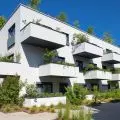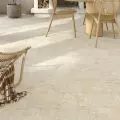Miriam Mik from the Faculty of Construction and Architecture at Opole University of Technology designed an ecological habitat in Estonia. The engineering work was carried out under the supervision of Iwona Wilczek and Dr. Marcin Galkowski.
The theme of the project was the creation of an ecological living environment, compatible with the alternative lifestyle of Tallinn residents. Miriam Mik's proposed concept combines residential development, services, public buildings and recreational activity zones with ecological solutions, improving the quality of life.
The project combines the two neighborhoods of Kalamaja and Peluglinin
© Miriam Mik
two neighborhoods merged into one
The main subject of the study is Tallinn's two neighborhoods - Kalamaja and Peluglinin. The author created a development on a modular grid of 8.10×8.10 meters, which was applied to the entire area. The idea was to introduce a residential function on the side of the city as a continuation of the way Kopla Street was developed. To relate to the character of the historic district, the student introduced gabled roofs with a forty-degree pitch in the new buildings.
reference to tradition
Residential structures with three floors alternate with a smaller communication module. The different types of apartments used (area from thirty to one hundred square meters) are designed for a diverse society (families, singles, etc.) Two types of facades of residential complexes are distinguished. The range of cladding refers to traditional materials (wood, brick and natural stone) found in the historic part of Tallinn. The development modules have also been connected with underground parking.
The facade of the buildings and the sloping roofs refer to traditional construction
© Miriam Mik
integration of residents
The area also includes educational facilities for art, music and biology and science. In the development, modules with integrative and service and leisure functions have been created, such as cafes and stores with local food. These zones allow integration between the residents of the development and the city. Provision has also been made for residential community meetings and special events. Service functions have been introduced on the side of the tracks running through the housing estates. To offset the problem of noise, the height of buildings in their vicinity was increased to four stories. In the services next to the traffic module, integration and recreation space was introduced, as well as libraries for employees and residents of the estate. Flat roofs covered with greenery were used to increase the biologically active area.
The author introduced a lot of greenery and ecological solutions
© Miriam Mik







































